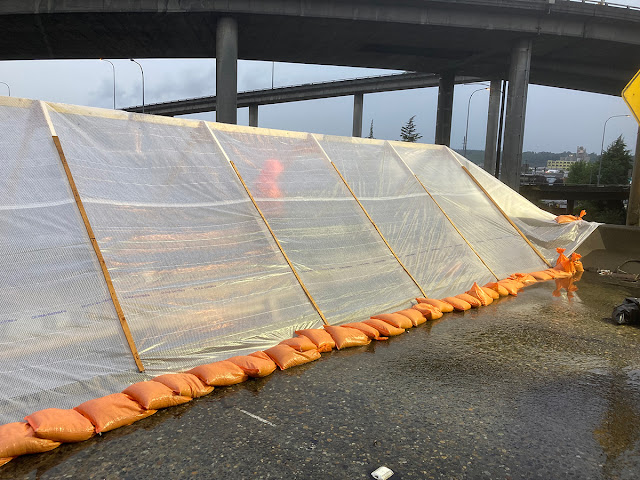By Amy Moreno
Let’s face it – a rainy weekend in June is never part of anyone’s plans! Barbra Streisand famously implored “don’t bring around a cloud to rain on my parade.” And twice this summer it’s rained on our “parade” that is the Revive I-5 work on southbound Interstate 5, forcing us to postpone planned construction.
The goal is to replace the bumpy expansion joints between I-90 and Spokane Street, some of them as old as I-5 itself.
The construction schedule was built with the likelihood we’d lose some weekends to rain. It’s the Pacific Northwest after all! When last week’s forecast showed another likely soggy shutdown, contractor CA Carey and their crews stepped up to see if they could make it work.
Their plan focused on replacing the right side of the three joints they started the weekend of May 21-22. That weekend they used a conservative approach targeting the left side of the joints at the southern end of the construction zone. Even with a potentially record-breaking rainy forecast, they went to work last Friday knowing it would be a challenge, made tougher by the moisture-sensitive polyester polymer concrete we use on this project.
 |
| Tents and sandbags work in light rain but it was a challenge when rain turned heavier this past weekend on our Revive I-5 project. |
Moisture-sensitive concrete in the PNW?
Polyester polymer concrete is a resin-based concrete material that we started using about 20 years ago. It has several benefits including providing a sort of seal in areas where the road was built with bare steel rebar, which could rust and corrode if it consistently gets wet.
The biggest benefit might come in how fast it cures. We can open the road up in as little as four hours after its done whereas the cement concrete material could take 41 or 42 hours.
There are some downsides to polyester concrete. It can have a slightly shorter lifespan and costs about 20 percent more. Another tricky thing about this material is it’s sort of like those gremlins from the campy ’80s movie.
“You don't want to get it wet!,” bridge engineer Andre La Foe said. “That resin literally cannot mix with water. It will mess it up.”
How did it go this weekend?
Our contractors scrambled to bring in extra crews and used the knowledge they gained from the May weekend to work as efficiently as possible. They constructed tents and brought in sandbags and blowers to help them work when the rain started.
They were able to get two of the joints done and concrete poured before the sky opened up Saturday evening. They used sandbags and tents to hold off the river of water that rolled down I-5 toward the joints that were in the process of curing.
When the rain grew heavier Saturday evening, they knew it would be a losing battle to pour the third joint so they waited it out for the worst of the storm to pass.
 |
| Tents kept work areas mostly dry so crews could work on the Revive I-5 project through a wet weekend. |
Sunday they sandblasted the last joint, poured the concrete and were able to open the freeway about eight hours early.
The contractor says the tents work fine when there’s a small amount of rain and could be used for future weekends with light rain in the forecast, but it was a struggle to keep the water out during Saturday’s heavy downpour. It was a difficult weekend for the crews and we applaud their efforts to move the project forward, despite the weather.
 |
| Work on the Revive I-5 project wrapped up Sunday evening as the clouds and rain moved out of the area. |
It was dark when I-5 reopened but you could see the storm clouds moving out as traffic cleared. Now the project is off for two weeks and will return on June 24, hopefully with sunnier skies on the horizon and we’ll be singing our own Streisand tunes. “Happy Days Are Here Again,” perhaps?
No comments:
WSDOT comment policy
Post a Comment